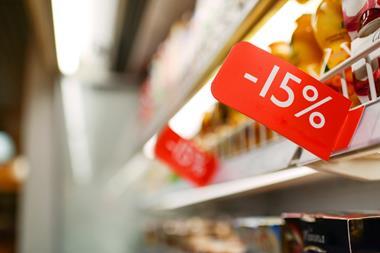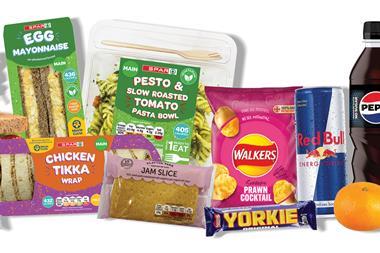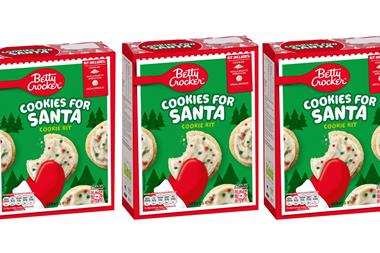A hearty breakfast is back on the menu as consumers look to save themselves some cash. Aidan Fortune shows how retailers can capitalise
There’s no doubt that this year is going to be a tough one for shoppers, who will be looking to save cash at every opportunity. And one of the ways many people have found to do this is to fill up on a large breakfast and then eat less for lunch, avoiding those pricey made-to-order sarnies and tempting take-aways. Although that may not be the best news for the overall economy, it could provide convenience store owners with something to celebrate.
Warburtons category strategy manager Martin Baptie says that bakery breakfast products have performed exceptionally well over the past year, and that the convenience channel has been a driver of this growth.
He sees bread as the initial purchase, leading to other breakfast products being bought alongside, providing a much-wanted boost to the overall basket spend.
Allied Bakeries category director Guy Shepherd agrees that bread is the key product for the breakfast market, and that retailers must get the section right. “Bread remains a crucial part of breakfast for most shoppers, with recent research from TNS revealing that toast with a cup of tea is the most frequently consumed breakfast combination in the UK,” he says.
“Breakfast also remains the single largest consumption occasion for bread, with 31% eaten at this time of day.”
He advises retailers to capitalise on this. “Bread is the third biggest driver to store in the convenience channel, and bread shoppers generate more than 50% more turnover than the average convenience shopper,” says Shepherd. “For this reason, it’s essential that retailers get the bread category right. Make sure your bakery section is eye-catching and appealing to customers. Keep bread in a high footfall area, and use effective and impactful signage to let customers know where they can find what they’re looking for.
“Retailers should make the most of consumers’ love of bread at breakfast by stocking a broad range of breads,” he continues. “From families looking for a hearty start to the day with the Kingsmill Doorstop, to those wanting a lighter bite with Kingsmill Danish, or the heathier Burgen Soya and Linseed loaf, retailers can boost sales by ensuring that they cater for every demand across the bread market.”
Shepherd says that consumers are looking for variation by mixing it up with different types of breakfast bakery products. “Consumers are increasingly looking for variation of bakery products at breakfast time. The ‘bakery favourites’ category has seen an increase in sales of 8.4% in the past year, with breakfast a key consumption occasion for these products. Allied Bakeries continues to lead in this category, with the Kingsmill range boasting the number-one branded muffin and the number-one branded pancake in the UK.”
Baptie has also seen demand for variation in bakery produce, but veering towards the sweeter side of the spectrum. “The ‘treat’ breakfast products such as croissants and brioche are in positive growth in the market, with annualised growth of more than 200,000 units in total impulse stores over the past year,” he points out. “Brioche is the second fastest growing product within the treat breakfast sector, with value sales growth of 23.17% in the past 52 weeks.”
Spread the word
While the bread sales are blooming so too are the fortunes of the allied butters, spreads and margarines (BSMs) category as, after all, the two are inextricably linked.
In convenience, the BSM market is worth £135.6m and, as butters, spreads and margarines are used by 99% of households, it is a valuable category for convenience retailers. Convenience is outperforming the total market and pulled in a 1.3% increase in sales last year. According to Unilever’s category management initiative Partners for Growth, the increase is coming from spreadable butters, which account for 26% of market share - an equal share to buttery spreads, but one which is growing at a greater rate.
“Butters and margarines are a kitchen essential, with a high proportion of ‘need it now’ purchases where consumers have run out and need to stock up quickly for packed lunches or baking,” says Tom Hazelden, Partners for Growth controller and Unilever convenience manager.
He advises retailers to stick to a tight range of the most popular brands and formats. “An amazing 90% of shoppers already know what brand of butter or margarine they want before they set foot inside the store,” he says.
Dairy Crest customer marketing manager Adam Mehegan says it’s important that retailers aren’t overwhelmed when it comes to stocking butters and spreads. “Retailers are faced with a huge choice of BSM lines, and should select a good breadth of products and top sellers to help boost profits,” he says. “Stocking the top brand butters and spreads is crucial, as BSM is a brand-rich category and consumers buy into the names they recognise and trust. Shoppers are willing to pay more for branded products, providing retailers with an opportunity to maximise the value of every butters and spreads sale.”
He adds that retailers should consider their customer base and stock accordingly. “Think about what your customers are looking for. Pack size is important, as larger family packs, such as 1kg tubs, aren’t appropriate for convenience stores as they can be expensive and don’t meet your shoppers’ needs,” says Mehegan.
Adapting to your shoppers’ needs is also a consideration when it comes to stocking jams and preservatives. Rowse Honey marketing manager Kirstie Jamieson believes people are consuming more varied products in the morning, and that’s having an impact on sales. “People are having more items for breakfast,” she says. “Before, they would have had toast, but now they will have porridge with fruit and honey as well.”
According to Jamieson, this is down to the economic downturn, with people looking to fill up early in the day to save money. “There’s a saying ‘eat like a king in the morning and a like pauper at dinner’. As well as being the most important meal of the day, it’s also the cheapest. A large breakfast eaten at home is much better value than having lunch or dinner out of the home.”
The total preserve market is down 2.3% in the convenience channel. However, honey has bucked this trend by showing a 3.9% growth (Nielsen 52 weeks ending October 1, 2011). Rowse has helped drive the growth in the honey sub-category and has seen a massive 23% year-on-year growth.
Rowse’s growth in the convenience channel is the result of a renewed focus by the brand on the sector over the past year. As well as pricemarked packs, it has offered six for the price of five case deals to retailers and had a large presence in wholesalers. Rowse also appeared on TV for the first time in 2011 with a campaign highlighting the homemade virtues of the brand. It will return to TV this year as part of a £4m advertising campaign.
Jamieson believes that there is great potential for the honey sub-category, especially in the convenience channel. “In any given year, only 40% of consumers will buy honey - it can and should be much higher than that,” she says. “Retailers can generate more sales of honey by stocking it close to other breakfast products such as bread and cereal. It doesn’t need to be tucked away beside the jams anymore. It’s a distinct and versatile product that more people need to be reminded about.”
Honey is not the only spreadable breakfast product to have a strong year. In 2011 Nutella 400g became the number-one SKU in the market in terms of value (Nielsen Value Sales Total Spreads 52 weeks ending September 24, 2011). It also grew 18% in terms of volume sales, selling 4.3 million units more than its closest rival.
Ferrero UK sales director Jason Sutherland attributes the achievement to a strong focus on educating consumers. “Our ‘Wake up to Nutella’ approach and support campaign has remained consistent over the past year, with a focus on educating shoppers that Nutella is not a chocolate spread, but a hazelnut spread, and its role at breakfast,” he says. “In-store has been another area of focus for us, and we’ve been working hard to increase Nutella’s visibility.”
Sutherland adds that retailers should consider varying their ranges and including more products to increase consumers’ choice.
“Based on its brand size and outstanding growth, Nutella should have its fair share of the fixture,” he says. “While we aren’t advocating limiting space on shelf to the traditional segments, we are recommending giving increased fixture space to growing segments. We are also highlighting the need to allocate correct presence on shelf for the largest brands within these growing segments.”
Cereal thriller
Kellogg’s head of specialist accounts Lee Doherty agrees with this advice, but urges retailers not to forget the breakfast staple items.
“Retailers need to ensure that they offer their customers a range of breakfast options. However, 97% of the British population eat breakfast cereal - a figure which cannot be overlooked,” he says. “Cereal is still the breakfast leader and convenience store retailers should stock the best-selling brands in order to appeal to shoppers.”
Doherty has this advice to retailers who want to make more of their cereal category: “These products should also be placed in a clearly visible position to attract the customer’s attention. I would recommend merchandising these by segment - for example, put the children’s products next to each other and so on.”
He adds that retailers need to cross-promote in order to increase basket spend. “Retailers should also consider placing secondary signage in the chiller because 38% of milk is consumed with cereal,” says Doherty. “If you sell milk, then this is a perfect opportunity to direct those milk shoppers to the cereal aisle to top up their basket.”
Of course, on a cold winter’s morning nothing beats a warm bowl of cereal to start the day, and according Kantar figures this is a sentiment shared by many. Hot cereal breakfast occasions have grown 70% in the past 10 years and have increased 13.5% year on year, outperforming ready-to-eat cereals.
Pepsico impulse sales director Jon Kyle says that this growth is a result of healthier lifestyles. “Health and convenience remain the key drivers in the breakfast products market,” he says. “The hot instant and traditional cereals segments are faring particularly well as consumers buy into maintaining a healthier cholesterol level through oat-based cereals.”
Good to go
According to a survey conducted earlier this year by food and retail research consultant Allegra, about 21% of consumers eat breakfast out of home. The research also found that the core consumers of out-of-home breakfasts are commuters. Country Choice marketing controller Stephen Clifford says stores need to start taking advantage of this. “For shops near construction sites, offices, transport hubs, industrial estates or on busy A roads, a hot breakfast offering is vital, and the earlier the start the better - at least 7am, if not before,” he says. “Outlets that offer hot breakfasts will often get a reputation locally and find they quickly build up a loyal and regular customer base.”
Clifford adds that the confectionery side of breakfast on the go has performed well in the past 12 months.
“Both the croissant and muffin categories showed excellent growth in 2010/11,” he says. “That growth appears to be driven in part by a trend towards all-day consumption, but also as an accompaniment to coffee at breakfast. A coffee and a croissant or muffin is, for many people, their regular breakfast, usually picked up on the way in to work. There is a slightly female bias to consumption and a general popularity among office workers. Retailers near offices or educational establishments often do a good trade in coffee and croissants or muffins before 9am, but extending to late morning for those who choose to take breakfast later.”
Pepsico has been looking to take advantage of the growing popularity of breakfast on the go. “23% of shoppers also ask for a breakfast meal deal and so we have been working with retailers to make the most of the on-the-go breakfast occasion,” says Kyle. “We have seen great success with our Quaker Oat So Simple Pots which perfectly fulfil this consumer need. Porridge is a naturally healthy, convenient and affordable breakfast all year round, and the new pot delivers the same taste expected from Quaker in a convenient on-the-go format.”
He believes breakfast deals shouldn’t be difficult for retailers to set up. “It is essential that retailers respond to demand and provide a range of on-the-go breakfast options such as Tropicana single-serve formats and Quaker Oat So Simple Pots. Position them close together to offer breakfast meal deals.”
Kellogg’s is also focusing on the out-of-home breakfast, believing that it is an area of potential.
“Food to go is a sector which is growing in the convenience store channel and we expect this trend to continue,” says Doherty. “There are more than four million missed breakfast occasions in the UK every year, often because people are strapped for time in the morning. It is, therefore, a great sales opportunity if you can offer your customer something that they can eat on the go, which is why big players in the breakfast market have extended their portfolios.”
Doherty says the answer is to stock the right breakfast products for busy people on the move. “Products such as Kellogg’s Nutri-Grain and other cereal bars and our individual pots of cereal are ideal for this as they can be eaten in transit or at the shopper’s destination,” he says.
“Remember, these consumers often miss breakfast because they are in a rush, so these products need to be clearly visible - don’t make shoppers work too hard to find them. Display them in a visible location, such as at the checkout point, as these items are more likely to be an impulse purchase.” ■ T
Source
Aidan Fortune




























No comments yet